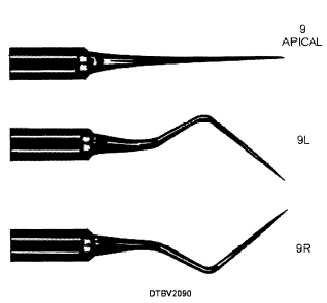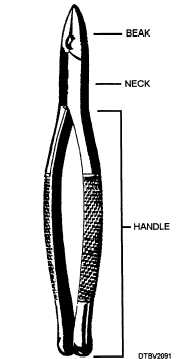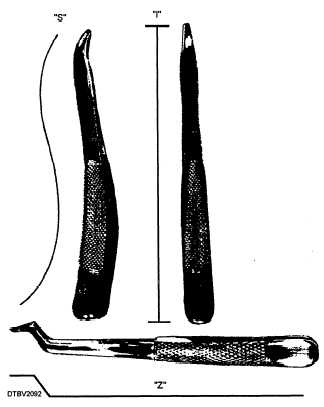
Figure 5-28. - Apical root tip picks (#9L and #9R).
TOOTH EXTRACTION FORCEPS
There are several types of tooth extracting forceps. Except for those made for some specific operation, they generally have the same features: beaks, a neck, and handles, as shown in figure 5-29. The beaks of tooth extracting forceps are designed to grasp the tooth with maximum contact on the facial-lingual surface of the root(s) just below the cervix. The inner surface of each of the two beaks is concave and the outer surface is convex.

Figure 5-29. - Parts of forceps.
Tooth extracting forceps are designed for use in specific areas of the mouth. The beak is always shaped to conform snugly to the contour of the tooth. For example, both beaks of maxillary forceps are usually angled away from the curvature of the handles. These varying angles make it easier to reach various parts of the arch. The beaks of mandibular forceps are usually at a much sharper angle and in the same direction as the curvature of the handles. This makes it easier to reach different parts of the lower arch.
Another way of identifying the general area of the mouth in which tooth extracting forceps should be used is by its neck. The neck is shaped so that the beak can be placed on the tooth and still be parallel with the long axis of the tooth. The handles are shaped so that a maximum amount of force can be applied to the beaks, while the handles are still in a comfortable position for the oral surgeon. The beaks are also shaped so that a force on the handles tends to force the tooth out of its socket.
The overall shape of the forceps, from the beak to the handle, can usually provide quick identification of the arch for which it's designed. The S, I, and Z shaped forceps are used on the maxillary arch (fig. 5-30). Forceps which are C and L shaped are used on the mandibular arch (fig. 5-31).

Figure 5-30. - Maxillary shaped extraction forceps.
Continue Reading